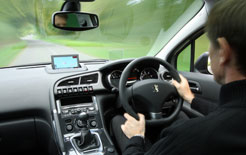
DESPITE ongoing publicity surrounding the revisions to the corporate manslaughter act which came into force in April 2008, many companies, particularly SMEs, are failing to review, implement and communicate an effective Work Related Road Safety (WRRS) policy. InStar’s managing director, Nick Mills, reports.
THE revisions to the corporate manslaughter act provide stronger powers for the police and Health and Safety Executive (HSE) to conduct investigations following an incident into a company’s provision of adequate health and safety at work policies.
In a concerted attempt to reduce road deaths and casualties Work Related Road Safety (WRRS) is firmly under the spotlight and relates to the safety of employees who drive as part of their work.
This is understandable when it is suggested that at least 30% of road collisions involve people who are at work and more recent figures suggest that 50% may be a more realistic figure.
Under the new rules, companies and senior management are accountable in the case of a fatal work related collision for any shortcomings in the procedures or systems that may be deemed to have contributed to the incident.
Research carried out by Rent-A-Car shows that more than one in three workers (35%) use their car for business purposes, making it the most common form of business transport.
Providing ‘cash for cars’ does not mean that a company absolves itself of responsibility for ensuring the safety of these vehicles and their drivers, managing the safety of these so called ‘grey’ drivers is difficult but cannot be ignored. Here are some facts to help senior managers manage ‘grey business cars’.
Set up a company work related road safety policy
Employers should not be daunted by the prospect, and once in place, providing it is enforced and reviewed periodically, it has been proven by many organisations to save money in terms of insurance premiums, accident repairs, out of service costs, accident administration, and employee sick leave/work injuries.
Risk-assess the company’s cars across the five core areas:
- legislation,
- health and safety,
- environmental,
- employee; and
- financial.
Set out rules, guidelines and procedures to help minimise ‘in house’ company cars and ‘grey’ privately owned cars used on business and put in place regular checks on insurance, MOTs, scheduled servicing and ensure basic maintenance checks are regularly carried out. Finally, ensure that an efficient audit trail is in place.
Compile a Driver Manual
This should contain the company policy and procedures, safe driving information, emergency contact information, procedures for reporting defects and repairs, what should be done in the case of an accident and outline essential vehicle checks.
It should be concise and easy to read and include practical advice.
Treat all drivers the same
Whether the employee is in a company car or drives their own vehicle, they should be treated exactly the same. The company work related road safety policy, driver manual and related training should be provided to all drivers. Businesses should ensure that all drivers regularly maintain their vehicles:
- Fluid levels and battery;
- Lights and windscreen wipers; and
- Tyre pressures and tread levels.
Ensure that they have business-use insurance for privately owned cars used on business as well as MOT and road tax.
Check driving licences
Check any new employees driving licence to confirm that they are eligible to drive. Implement a regular check on driving licences to keep track of penalty points and possible driving bans and maintain a driver file to monitor driver’s safety records and behaviour.
Ensure all drivers are prepared in the event of an emergency.
Company car users should be equipped with safety packs including torch, high visibility clothing, warning triangle, and breakdown contact information. Employers should ensure grey fleet drivers are supplied with exactly the same safety equipment.
Education
Carry out training where appropriate and warn against drugs and alcohol whilst driving. It is also important to give drivers plenty of time to get to their next location and don’t set impossible schedules – this is especially relevant in the delivery and courier sector where the setting of productivity bonuses which might affect driver safety will be viewed upon negatively in the event of a road traffic incident.
Further information
If the term ‘grey’ or ‘grey fleet’ is new to you it refers to drivers who use their own cars on company business.
In April 2008, revisions to the Corporate Manslaughter and Corporate Homicide Act 2007 came into force in the UK. The Act enables an organisation to be found guilty of an offence under the Act, if the way in which its activities are managed or organised causes a person’s death, and amounts to a gross breach or failure of a relevant duty of care owed by the organisation to the deceased.







